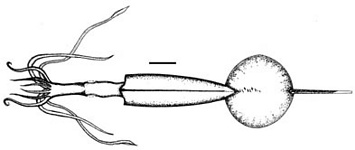

Figure. Dorsal view of the 96 mm ML paralarva. Scale bar is 15 mm. © K. Nesis and I. Nikitina
Introduction
Two doratopsid paralarvae (42 and 96 mm ML) were first described as Chiroteuthis n. sp. (Nesis, 1974) and later identified as Chiroteuthidae n. gen. B (Nesis, 1982). These paralarvae are unusual in having six series of suckers present on the developing adult club. Although the importance of this feature is now uncertain, the structure of the funnel locking-apparatus is also unusual. The illustrations below were provided by Kir Nesis.
Characteristics
- Arms
- Arms IV not thicker but longer then others.
- Suckers on arms IV in one zigzag-like series.
- Suckers with 8-9 long, blunt teeth distally; smooth proximally.
- Tentacular club
- Developing adult club with suckers in six series.
- Doratopsid club (=distal portion of club) with aboral elongated yellowish swelling between keel and protective membrane (indicated by arrow).
- Suckers (developing club) with 3-4 sharp teeth, no prominent central tooth.
- Photophores
- Present, possibly unpaired, on ink sac.
- Funnel
- Locking apparatus with rounded antitragus, no tragus.
Comments
The swelling on the doratopsid club was originally described as a photophore (Nesis, 1974). His re-examination of the specimen shows that the swelling has no pigment nor lens and is located under skin covered with normal chromatophores. As a result, the function of this tissue is uncertain. Eyes were absent from the paralarva illustrated and the gladius was broken off at 22.5 mm beyond the fin. The total length of the paralarva, with tentacles, is about 180 mm.
The peculiar arrangement of suckers on the presumptive adult club is peculiar but does not necessarily indicate that the adult club will have six sucker series. Naef (1923) noted a similar situation in a doratopsis of C. veranyi from the Mediterranean. He states (p.389), "However, the longitudinal rows on the [presumptive adult club] become zigzag rows because the oblique and transverse rows are slightly displaced and alternating. This is thus not a simple quadriserial arangement but a transition between a quadriserial and an octoserial arrangement, which apparently later reverts to the basic quadriserial type." Young (1991) noted numerous series of sucker buds on the presumptive adult club of C. picteti doratopsis as had Sasaki (1929) in his small C. borealis (= C. picteti) doratopsis. Whether or not the distinct hexiserial arrangement of suckers on the presumptive adult club of this large doratopsis described here proves to be different, remains to be determined.
Phylogenetic Position
If photophores occur on the ink sac suggests, this species could belong to Chiroteuthis. The funnel locking-apparatus, however is unlike any Chiroteuthis species. The locking apparatus, however, is similar to that of Asperoteuthis nesisi and Clarke's ?Mastigoteuthis A which are now included under Asperoteuthis lui. Indeed Nesis (1982/87) suggested that his and Clarke's species were the same. The presence of a protective membrane proxminal to the sucker bearing region of the club (see drawing above) also suggests that this species is an Asperoteuthis.
Therefore, Nesis's peculiar squid is probably a young Asperoteuthis nesisi. However, until our understanding of the arrangement of club suckers and their changes with growth are better understood, some doubt remains.
Distribution
The two paralarvae were taken in a single, open Isaacs-Kidd trawl that fished at a depth of about 350m at 40°06.6'S, 49°59'W in the southwestern Atlantic Ocean.






 Go to quick links
Go to quick search
Go to navigation for this section of the ToL site
Go to detailed links for the ToL site
Go to quick links
Go to quick search
Go to navigation for this section of the ToL site
Go to detailed links for the ToL site